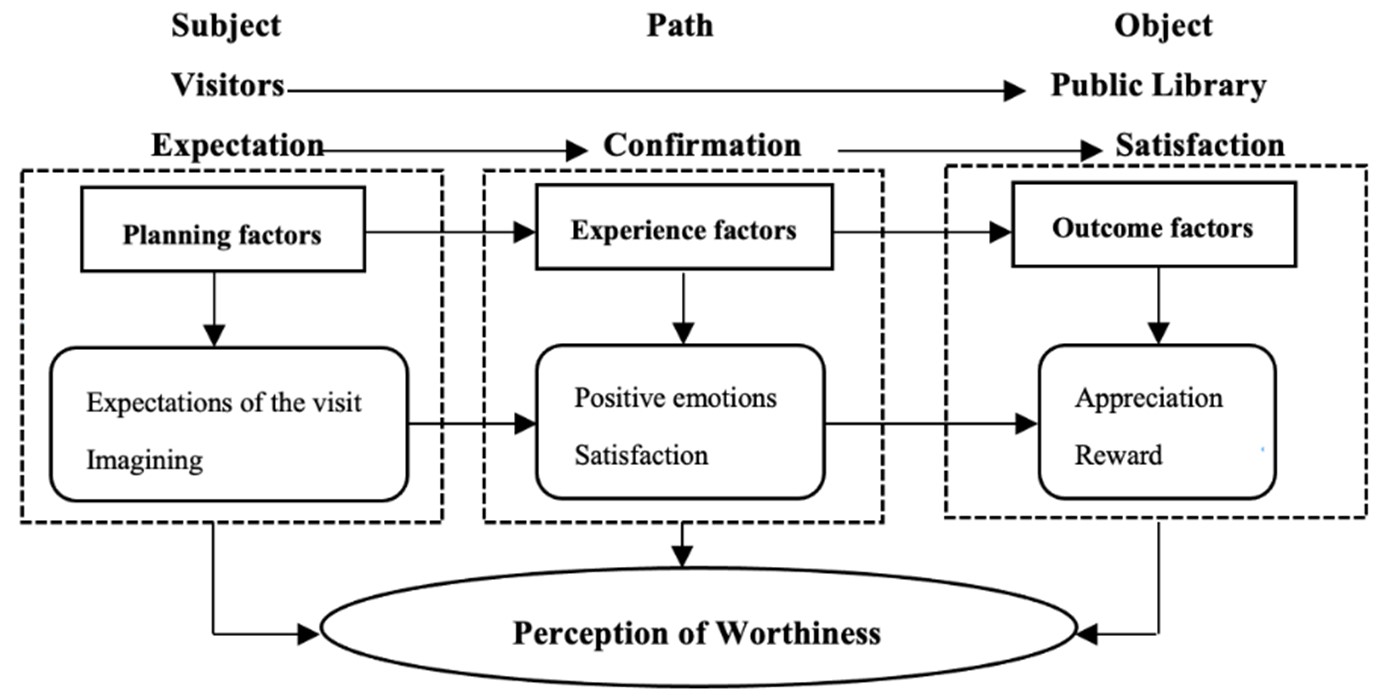The Mechanism of the Multidimensional Formation of Public Library Visitors' Perception of Worthiness: A Grounded Theoretical Exploration Based on Online Review Data
Abstract
This paper explores the reasons why public libraries attract visitors by studying the formation mechanism of the public library visitors' perception of worthiness. Taking the New York Public Library as an example, this paper uses the grounded theory method to conduct a qualitative analysis of the online English reviews on the TripAdvisor website, and innovatively combines the perceived value theory with the expectation confirmation theory to classify the perceived worthiness dimensions of visitors', revealing three dimensions of perceivable value: Planning factors, experience factors and outcome factors, as well as six sub-dimensions (main categories): visit expectation, imagination, positive emotions, satisfaction, appreciation and reward. A visitors' expectation confirmation model of perception of worthiness is constructed. The research results of this paper theoretically provide an example for the expectation confirmation theory, supplement multiple dimensions perception of worthiness for the perceived value theory, and provide suggestions for public libraries to play a cultural function, enhance their attractiveness, and meet the diverse needs of visitors in practice.
References
[2] Schloffel-Armstrong, S., Baker, T., & Kearns, R. A. (2021). Geographies of the public library: Institutions, architectures, interactions. Geography Compass, 15(10), e12592. https://doi.org/10.1111/gec3.12592
[3] Audunson, R., Aabø, S., et al. (2019). Public libraries as an infrastructure for a sustainable public sphere: A comprehensive review of research. Journal of Documentation, 75(4), 773–790. https://doi.org/10.1108/JD-10-2018-0157
[4] Vårheim, A., Skare, R., & Lenstra, N. (2019). Examining libraries as public sphere institutions: Mapping questions, methods, theories, findings, and research gaps. Library & Information Science Research, 41(2), 93–101. https://doi.org/10.1016/j.lisr.2019.04.001
[5] Peterson, M. (2023). Libraries as felt spaces: Atmospheres, public space and feelings of dis/comfort. Emotion, Space and Society, 49, 100986. https://doi.org/10.1016/j.emospa.2023.100986
[6] Connell, K., Jones, H., Neale, S., Moran, G., Cochrane, A., & Bennett, K. (2015). Urban multiculture and everyday encounters in semi-public, franchised cafe spaces. The Sociological Review, 63(3), 644–661. https://doi.org/10.1111/1467-954X.12311
[7] Barclay, D. A. (2017). Space and the social worth of public libraries. Public Library Quarterly, 36(4), 267–273. https://doi.org/10.1080/01616846.2017.1327767
[8] Johnson, C. A. (2010). Do public libraries contribute to social capital? A preliminary investigation into the relationship. Library & Information Science Research, 32(2), 147–155. https://doi.org/10.1016/j.lisr.2009.12.006
[9] Wojciechowska, M. D. (2021). The role of public libraries in the development of social capital in local communities – A theoretical study. Library Management, 42(3), 184–196. https://doi.org/10.1108/LM-10-2020-0139
[10] Wyatt, D., & Leorke, D. (2024). Playing in the “third place”: How games and play are transforming public libraries. Space and Culture, 27(2), 254–273. https://doi.org/10.1177/12063312231223118
[11] Mickiewicz, P. (2016). Access and its limits: The contemporary library as a public space. Space and Culture, 19(3), 237–250. https://doi.org/10.1177/1206331215596478
[12] Wood, E. (2020). Libraries full circle: The cross section of community, the public sphere, and third place. Public Library Quarterly, 40(2), 144–166. https://doi.org/10.1080/01616846.2020.1737491
[13] Morgado, F., Nakano, M., Vizim, M., Ribeiro, A. C., Lima, C. M. S., & Garson, P. C. (2022). Living library as a third place: An encounter of generations in times of uncertainty. Foro de Educación, 20(1), 197–213. https://doi.org/10.14516/fde.932
[14] Agyekum, B. (2022). Public libraries: Enacting “public spaces” for community development and lifelong learning. Journal of Learning Spaces, 11(1), 45–57.
[15] Robinson, K. (2020). Everyday multiculturalism in the public library: Taking knitting together seriously. Sociology, 54(3), 556–572. https://doi.org/10.1177/0038038519899352
[16] Mady, C., & Hewidy, H. (2025). The public library building as nexus for social interactions: Cases from Helsinki. City, Culture and Society, 40, 100610. https://doi.org/10.1016/j.ccs.2024.100610
[17] Zeithaml, V. A. (1988). Consumer perceptions of price, quality and value: A means-end model and synthesis of evidence. Journal of Marketing, 52, 2–22. https://doi.org/10.1177/002224298805200302
[18] Eid, R., & El-Gohary, H. (2015). The role of Islamic religiosity on the relationship between perceived value and tourist satisfaction. Tourism Management, 46, 477–488. https://doi.org/10.1016/j.tourman.2014.08.003
[19] Pandža Bajs, I. P. (2015). Tourist perceived value, relationship to satisfaction, and behavioral intentions: The example of the Croatian tourist destination Dubrovnik. Journal of Travel Research, 43(1), 171–189. https://doi.org/10.1177/0047287513513158
[20] Liu, J., Qu, H., Huang, D., Chen, G., Yue, X., Zhao, X., & Liang, Z. (2014). The role of social capital in encouraging residents' pro-environmental behaviors in community-based ecotourism. Tourism Management, 41, 190–201. https://doi.org/10.1016/j.tourman.2013.08.016
[21] Qiu, N., Li, H., Pan, C., Wu, J., & Guo, J. (2024). The study on the relationship between perceived value, satisfaction, and tourist loyalty at industrial heritage sites. Heliyon, 10(17), e37184. https://doi.org/10.1016/j.heliyon.2024.e37184
[22] Jiang, T., Xu, Y., Li, Y., & Xia, Y. (2025). Integration of public libraries and cultural tourism in China: An analysis of library attractiveness components based on tourist review mining. Information Processing and Management, 62, 104000. https://doi.org/10.1016/j.ipm.2024.104000
[23] Lin, T.-C., Wu, S., Hsu, J. S.-C., & Chou, Y.-C. (2012). The integration of value-based adoption and expectation–confirmation models: An example of IPTV continuance intention. Decision Support Systems, 54(1), 63–75. https://doi.org/10.1016/j.dss.2012.04.004
[24] Kim, H.-W., Chan, H. C., & Gupta, S. (2007). Value-based adoption of mobile internet: An empirical investigation. Decision Support Systems, 43(1), 111–126. https://doi.org/10.1016/j.dss.2005.05.009
[25] Oliver, R. L. (1980). A cognitive model of the antecedents and consequences of satisfaction decisions. Journal of Marketing Research, 17, 460–469. https://doi.org/10.2307/3150499
[26] Gupta, A., Dhiman, N., Yousaf, A., & Arora, N. (2020). Social comparison and continuance intention of smart fitness wearables: An extended expectation confirmation theory perspective. Behaviour & Information Technology, 40(13), 1341–1354. https://doi.org/10.1080/0144929X.2020.1748715
[27] Bhattacherjee, A. (2001). Understanding information systems continuance: An expectation-confirmation model. MIS Quarterly, 25(3), 351–370. https://doi.org/10.2307/3250921
[28] Wu, I.-L., Chiu, M.-L., & Chen, K.-W. (2020). Defining the determinants of online impulse buying through a shopping process of integrating perceived risk, expectation-confirmation model, and flow theory issues. International Journal of Information Management, 52, 102099. https://doi.org/10.1016/j.ijinfomgt.2020.102099
[29] Ibrahim, A. J., Hashim, N. H., & Al-Ghazali, B. M. (2020). The role of cognitive absorption in predicting mobile internet users’ continuance intention: An extension of the expectation-confirmation model. Technology in Society, 63, 101355. https://doi.org/10.1016/j.techsoc.2020.101355
[30] Oliver, R. L., & Burke, R. R. (1999). Expectation processes in satisfaction formation: A field study. Journal of Service Research, 1(3), 96–214. https://doi.org/10.1177/109467059913002
[31] Nam, K., Baker, J., Ahmad, N., & Goo, J. (2020). Determinants of writing positive and negative electronic word-of-mouth: Empirical evidence for two types of expectation confirmation. Decision Support Systems, 129, 113168. https://doi.org/10.1016/j.dss.2019.113168
[32] Glaser, B. G., & Strauss, A. L. (1967). The discovery of grounded theory: Strategies for qualitative research. Chicago: Aldine Publishing Company.
[33] Mohajan, D., & Mohajan, H. K. (2022). Development of grounded theory in social sciences: A qualitative approach. Studies in Social Science & Humanities, 1(5), 13–24. https://doi.org/10.56397/SSSH.2022.12.02
[34] Prigol, E. L., & Behrens, M. A. (2019). Grounded theory: Methodology applied in education research. Educação & Realidade, 44. https://doi.org/10.1590/2175-623684611
[35] Zhang, W., Zhang, M., Zhang, W., Zhou, Q., & Zhang, X. (2020). What influences the effectiveness of green logistics policies? A grounded theory analysis. Science of The Total Environment, 714, 136731. https://doi.org/10.1016/j.scitotenv.2020.136731
[36] Qi, Y., Han, J., Lu, X., Wang, Z., Ren, H., & Zhang, X. (2024). A study on satisfaction evaluation of Chinese mainstream short video platforms based on grounded theory and CRITIC-VIKOR. Heliyon, 10(9), e30050. https://doi.org/10.1016/j.heliyon.2024.e30050
[37] Qian, J., Shi, L., & Law, R. (2025). Unveiling memorable hotel experiences: A grounded theory analysis of international tourists’ journey at Yanggakdo Hotel in Pyongyang. International Journal of Hospitality Management, 128, 104161. https://doi.org/10.1016/j.ijhm.2025.104161
[38] Ayeh, J. K., Au, N., & Law, R. (2013). "Do we believe in TripAdvisor?" Examining credibility perceptions and online travelers' attitude toward using user-generated content. Journal of Travel Research, 52(4), 437–452. https://doi.org/10.1177/0047287512475217
[39] Filieri, R., Alguezaui, S., & McLeay, F. (2015). Why do travelers trust TripAdvisor? Antecedents of trust towards consumer-generated media and its influence on recommendation adoption and word of mouth. Tourism Management, 51, 174–185. https://doi.org/10.1016/j.tourman.2015.05.007
[40] Krueger, A. (2019, August 10). Where libraries are the tourist attractions. The New York Times. Retrieved from https://www.nytimes.com/2019/08/10/travel/libraries-are-the-tourist-attractions.html


This work is licensed under a Creative Commons Attribution 4.0 International License.
Copyright for this article is retained by the author(s), with first publication rights granted to the journal.
This is an open-access article distributed under the terms and conditions of the Creative Commons Attribution license (http://creativecommons.org/licenses/by/4.0/).









1.png)














